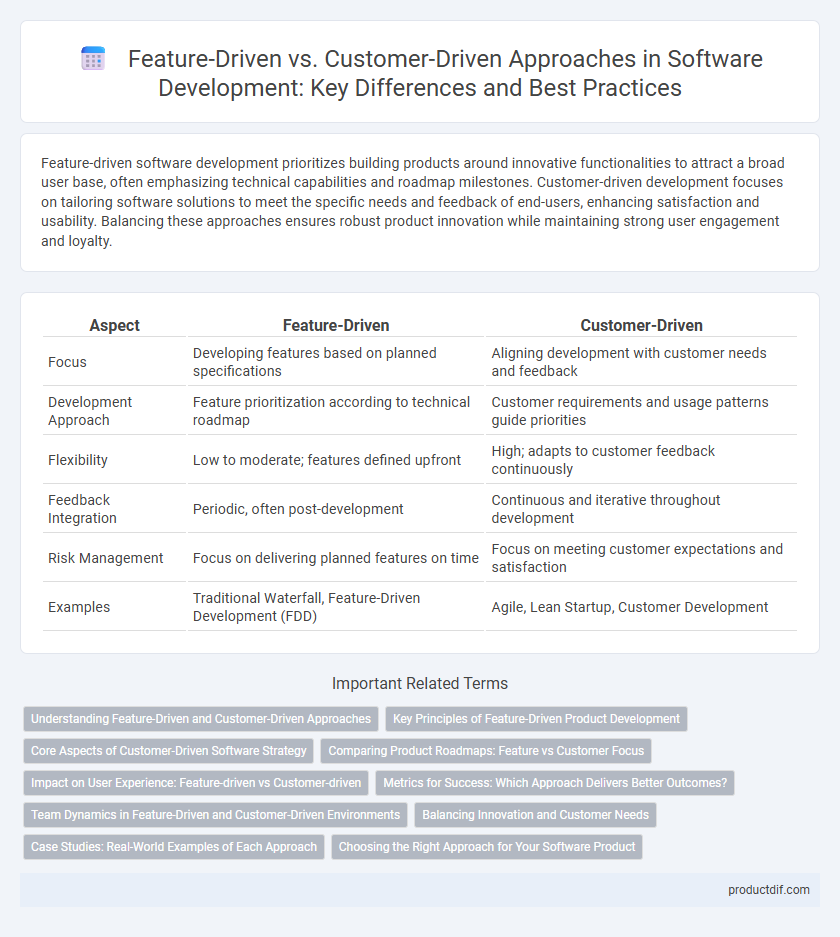Feature-driven software development prioritizes building products around innovative functionalities to attract a broad user base, often emphasizing technical capabilities and roadmap milestones. Customer-driven development focuses on tailoring software solutions to meet the specific needs and feedback of end-users, enhancing satisfaction and usability. Balancing these approaches ensures robust product innovation while maintaining strong user engagement and loyalty.
Table of Comparison
| Aspect | Feature-Driven | Customer-Driven |
|---|---|---|
| Focus | Developing features based on planned specifications | Aligning development with customer needs and feedback |
| Development Approach | Feature prioritization according to technical roadmap | Customer requirements and usage patterns guide priorities |
| Flexibility | Low to moderate; features defined upfront | High; adapts to customer feedback continuously |
| Feedback Integration | Periodic, often post-development | Continuous and iterative throughout development |
| Risk Management | Focus on delivering planned features on time | Focus on meeting customer expectations and satisfaction |
| Examples | Traditional Waterfall, Feature-Driven Development (FDD) | Agile, Lean Startup, Customer Development |
Understanding Feature-Driven and Customer-Driven Approaches
Feature-driven software development emphasizes building and delivering specific product features based on pre-defined requirements and technical specifications. Customer-driven approaches prioritize gathering continuous user feedback and adapting the software to evolving customer needs, fostering higher user satisfaction and engagement. Balancing feature-driven planning with customer-driven responsiveness enhances product relevance and accelerates market success.
Key Principles of Feature-Driven Product Development
Feature-driven product development emphasizes building software around specific, well-defined features that deliver tangible value and are prioritized based on their impact on the overall user experience. Key principles include iterative design focused on feature sets, continuous client feedback integration, and maintaining clear progress visibility through regular feature completion reviews. This approach ensures alignment with business goals by breaking down development into manageable, feature-centric tasks that enhance both speed and quality.
Core Aspects of Customer-Driven Software Strategy
Customer-driven software strategy prioritizes user feedback, behavior analytics, and market trends to guide development, ensuring solutions directly address client needs and enhance user satisfaction. Core aspects include continuous customer engagement, adaptive feature prioritization based on evolving demands, and seamless integration of user experience improvements. This approach results in higher retention rates, personalized functionalities, and accelerated innovation cycles compared to feature-driven models.
Comparing Product Roadmaps: Feature vs Customer Focus
Feature-driven product roadmaps prioritize the development of specific functionalities and technical advancements to enhance the software's capabilities. Customer-driven roadmaps center on user needs and feedback, shaping product evolution based on customer pain points and market demand. Comparing the two, feature-driven approaches emphasize innovation and technical milestones, while customer-driven strategies focus on user satisfaction and retention metrics.
Impact on User Experience: Feature-driven vs Customer-driven
Feature-driven software development emphasizes delivering predefined functionalities, often resulting in a consistent but generic user experience. Customer-driven approaches prioritize user feedback and evolving needs, enhancing personalization and satisfaction. This leads to more adaptive interfaces and increased user engagement in customer-driven projects.
Metrics for Success: Which Approach Delivers Better Outcomes?
Feature-driven software development prioritizes dense feature sets measured by deployment frequency, feature adoption rates, and defect density to gauge success. Customer-driven approaches emphasize user satisfaction metrics, retention rates, net promoter scores (NPS), and customer lifetime value (CLV) to assess impact. Data indicates customer-driven strategies often yield higher long-term engagement and revenue growth by aligning development with user needs.
Team Dynamics in Feature-Driven and Customer-Driven Environments
Feature-driven teams emphasize structured roles and clear milestones to optimize software delivery, fostering collaboration and accountability within specialized units. Customer-driven teams prioritize adaptability and frequent client feedback, promoting cross-functional collaboration and dynamic responsiveness to evolving user needs. Understanding team dynamics in these environments helps improve communication efficiency and aligns development processes with strategic business goals.
Balancing Innovation and Customer Needs
Feature-driven software development emphasizes building functionalities based on a predefined roadmap, prioritizing innovation and technical advancements to differentiate products in competitive markets. Customer-driven approaches center on integrating user feedback and evolving customer requirements, ensuring solutions remain aligned with actual user needs and enhance satisfaction. Balancing these perspectives requires iterative cycles that validate innovative features through direct customer engagement, optimizing both product relevance and groundbreaking capabilities.
Case Studies: Real-World Examples of Each Approach
Feature-driven software development emphasizes delivering specific functionalities rapidly, as seen in Spotify's modular architecture that prioritizes new feature deployment to enhance user engagement. Customer-driven development, exemplified by Amazon, integrates continuous user feedback to refine and tailor product experiences dynamically, ensuring alignment with evolving customer needs. Case studies highlight that feature-driven approaches excel in innovation speed, while customer-driven methods excel in adaptability and user satisfaction.
Choosing the Right Approach for Your Software Product
Feature-driven development prioritizes delivering specific functionalities based on a predefined roadmap, ensuring rapid progress and measurable milestones. Customer-driven development emphasizes user feedback and market demands, shaping the product iteratively to enhance user satisfaction and adaptability. Selecting the right approach depends on project scope, timeline, and target audience, balancing innovation speed with user-centric design.
Feature-driven vs Customer-driven Infographic

 productdif.com
productdif.com